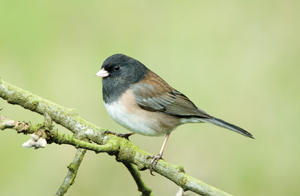 BIRD OF THE MONTH: DARK-EYED JUNCO
BIRD OF THE MONTH: DARK-EYED JUNCO
The Dark-eyed Junco is a medium-sized sparrow. It has a round head, a pale pinkish bill and a long tail with white outer feathers that flash while in flight. The male has a dark brown/black hood, a light brown back , buff-colored sides and a white belly. The female has more of a gray hood and is duller and browner overall.
The name "junco" is derived from the Latin word for the rush plants found in wetlands. Dark-eyed Juncos are often called "Snowbirds" maybe due to the fact that many people believe their return from their northern breeding grounds foretells the return of cold, snowy weather. Another possible source for the nickname may be the white belly feathers and slate colored back of the junco which has been described as "leaden skies above, snow below".
Dark-eyed Juncos prefer to roost in evergreens at night but will also use tall grasses and brush piles. They will return to the same roosting site repeatedly and will share it with other flock mates but they will not huddle together.
When nesting time arrives, the female will build a cup-shaped nest on or near the ground and lay 3 - 5 eggs. Typically, they will have two broods a year. The male does not help with incubation of the eggs but does deliver food to the chicks and helps the female defend against predators. Rodents such as chipmunks and deer mice are probably the major predators of junco eggs.
After hatching, the young will leave the nest in 9 - 12 days.
A junco's diet is made up of approximately three parts seed to one part insects. During nesting season the percentage of insects may increase to 50 - 60% of their diet. The seeds of chickweed, ragweed, knotweed, pigweed, lamb's quarters and crabgrass are particularly appealing natural seed sources used by juncos. You can attract these birds to your yard by offering a seed blend with millet and hulled sunflower seeds.
Dark-eyed Juncos can be quite creative in their pursuit of seeds. They have been know to burrow through the snow in search of these tasty morsels. They also practice an interesting foraging method called "riding" where they will fly up to a seed cluster on the top of a grass stem and "ride" it to the ground where they pick off the seeds while standing on it.
Project Feeder Watch reports that juncos are sighted at more feeding areas across North America than any other bird. Over 80% of those responding reported juncos at their feeders.
A study in New Hampshire found that juncos spend over 65% of their time on the ground, 20% in shrubs and 16% in saplings or low trees. They were never observed in the canopy of large trees.
Male Dark-eyed Juncos return and reclaim the same breeding territory year after year. Chances are you have many of the same birds at your feeder this winter that you've had in previous years.
Dark-eyed Juncos will have over 30% more feathers by weight in the winter than they do in summer. They will spend the entire winter in a flock averaging in size from 6 - 30 or more birds. Within the flock a hierarchy will be established with adult males at the top, then juvenile males, adult females and finally, young females.
The population of Dark-eyed Juncos is abundant. In North America it is estimated at 260 million birds.
The oldest Dark-eyed Junco on record lived to be 11 years, 4 months old.

